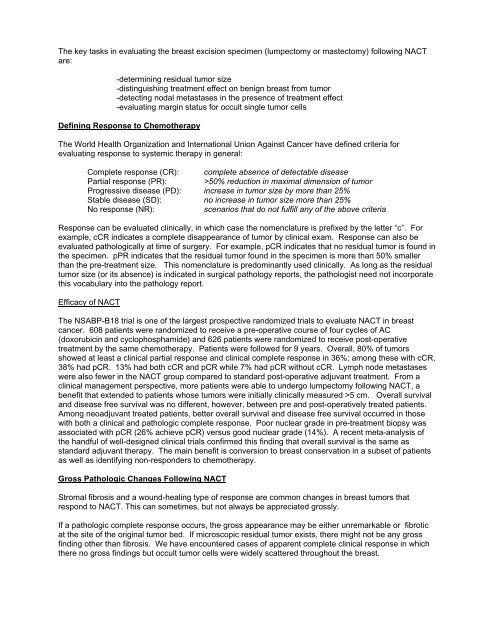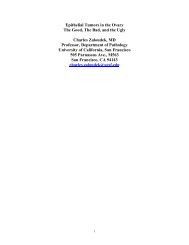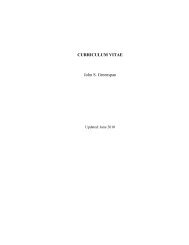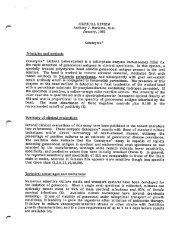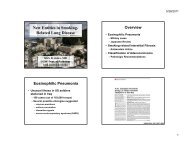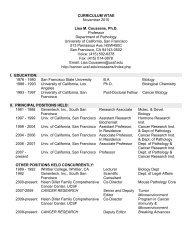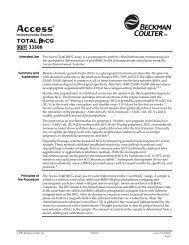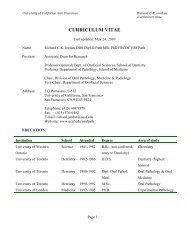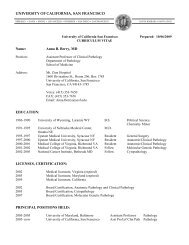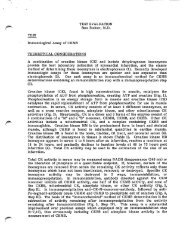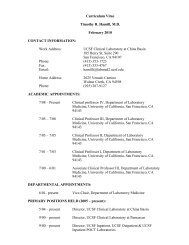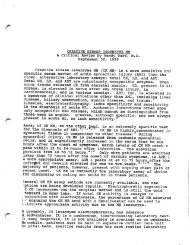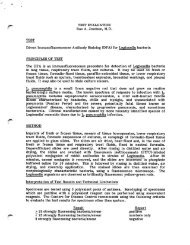Treatment Induced Changes in the Breast: Diagnosis and Staging of ...
Treatment Induced Changes in the Breast: Diagnosis and Staging of ...
Treatment Induced Changes in the Breast: Diagnosis and Staging of ...
Create successful ePaper yourself
Turn your PDF publications into a flip-book with our unique Google optimized e-Paper software.
The key tasks <strong>in</strong> evaluat<strong>in</strong>g <strong>the</strong> breast excision specimen (lumpectomy or mastectomy) follow<strong>in</strong>g NACT<br />
are:<br />
-determ<strong>in</strong><strong>in</strong>g residual tumor size<br />
-dist<strong>in</strong>guish<strong>in</strong>g treatment effect on benign breast from tumor<br />
-detect<strong>in</strong>g nodal metastases <strong>in</strong> <strong>the</strong> presence <strong>of</strong> treatment effect<br />
-evaluat<strong>in</strong>g marg<strong>in</strong> status for occult s<strong>in</strong>gle tumor cells<br />
Def<strong>in</strong><strong>in</strong>g Response to Chemo<strong>the</strong>rapy<br />
The World Health Organization <strong>and</strong> International Union Aga<strong>in</strong>st Cancer have def<strong>in</strong>ed criteria for<br />
evaluat<strong>in</strong>g response to systemic <strong>the</strong>rapy <strong>in</strong> general:<br />
Complete response (CR): complete absence <strong>of</strong> detectable disease<br />
Partial response (PR): >50% reduction <strong>in</strong> maximal dimension <strong>of</strong> tumor<br />
Progressive disease (PD): <strong>in</strong>crease <strong>in</strong> tumor size by more than 25%<br />
Stable disease (SD): no <strong>in</strong>crease <strong>in</strong> tumor size more than 25%<br />
No response (NR): scenarios that do not fulfill any <strong>of</strong> <strong>the</strong> above criteria<br />
Response can be evaluated cl<strong>in</strong>ically, <strong>in</strong> which case <strong>the</strong> nomenclature is prefixed by <strong>the</strong> letter “c”. For<br />
example, cCR <strong>in</strong>dicates a complete disappearance <strong>of</strong> tumor by cl<strong>in</strong>ical exam. Response can also be<br />
evaluated pathologically at time <strong>of</strong> surgery. For example, pCR <strong>in</strong>dicates that no residual tumor is found <strong>in</strong><br />
<strong>the</strong> specimen. pPR <strong>in</strong>dicates that <strong>the</strong> residual tumor found <strong>in</strong> <strong>the</strong> specimen is more than 50% smaller<br />
than <strong>the</strong> pre-treatment size. This nomenclature is predom<strong>in</strong>antly used cl<strong>in</strong>ically. As long as <strong>the</strong> residual<br />
tumor size (or its absence) is <strong>in</strong>dicated <strong>in</strong> surgical pathology reports, <strong>the</strong> pathologist need not <strong>in</strong>corporate<br />
this vocabulary <strong>in</strong>to <strong>the</strong> pathology report.<br />
Efficacy <strong>of</strong> NACT<br />
The NSABP-B18 trial is one <strong>of</strong> <strong>the</strong> largest prospective r<strong>and</strong>omized trials to evaluate NACT <strong>in</strong> breast<br />
cancer. 608 patients were r<strong>and</strong>omized to receive a pre-operative course <strong>of</strong> four cycles <strong>of</strong> AC<br />
(doxorubic<strong>in</strong> <strong>and</strong> cyclophosphamide) <strong>and</strong> 626 patients were r<strong>and</strong>omized to receive post-operative<br />
treatment by <strong>the</strong> same chemo<strong>the</strong>rapy. Patients were followed for 9 years. Overall, 80% <strong>of</strong> tumors<br />
showed at least a cl<strong>in</strong>ical partial response <strong>and</strong> cl<strong>in</strong>ical complete response <strong>in</strong> 36%; among <strong>the</strong>se with cCR,<br />
38% had pCR. 13% had both cCR <strong>and</strong> pCR while 7% had pCR without cCR. Lymph node metastases<br />
were also fewer <strong>in</strong> <strong>the</strong> NACT group compared to st<strong>and</strong>ard post-operative adjuvant treatment. From a<br />
cl<strong>in</strong>ical management perspective, more patients were able to undergo lumpectomy follow<strong>in</strong>g NACT, a<br />
benefit that extended to patients whose tumors were <strong>in</strong>itially cl<strong>in</strong>ically measured >5 cm. Overall survival<br />
<strong>and</strong> disease free survival was no different, however, between pre <strong>and</strong> post-operatively treated patients.<br />
Among neoadjuvant treated patients, better overall survival <strong>and</strong> disease free survival occurred <strong>in</strong> those<br />
with both a cl<strong>in</strong>ical <strong>and</strong> pathologic complete response. Poor nuclear grade <strong>in</strong> pre-treatment biopsy was<br />
associated with pCR (26% achieve pCR) versus good nuclear grade (14%). A recent meta-analysis <strong>of</strong><br />
<strong>the</strong> h<strong>and</strong>ful <strong>of</strong> well-designed cl<strong>in</strong>ical trials confirmed this f<strong>in</strong>d<strong>in</strong>g that overall survival is <strong>the</strong> same as<br />
st<strong>and</strong>ard adjuvant <strong>the</strong>rapy. The ma<strong>in</strong> benefit is conversion to breast conservation <strong>in</strong> a subset <strong>of</strong> patients<br />
as well as identify<strong>in</strong>g non-responders to chemo<strong>the</strong>rapy.<br />
Gross Pathologic <strong>Changes</strong> Follow<strong>in</strong>g NACT<br />
Stromal fibrosis <strong>and</strong> a wound-heal<strong>in</strong>g type <strong>of</strong> response are common changes <strong>in</strong> breast tumors that<br />
respond to NACT. This can sometimes, but not always be appreciated grossly.<br />
If a pathologic complete response occurs, <strong>the</strong> gross appearance may be ei<strong>the</strong>r unremarkable or fibrotic<br />
at <strong>the</strong> site <strong>of</strong> <strong>the</strong> orig<strong>in</strong>al tumor bed. If microscopic residual tumor exists, <strong>the</strong>re might not be any gross<br />
f<strong>in</strong>d<strong>in</strong>g o<strong>the</strong>r than fibrosis. We have encountered cases <strong>of</strong> apparent complete cl<strong>in</strong>ical response <strong>in</strong> which<br />
<strong>the</strong>re no gross f<strong>in</strong>d<strong>in</strong>gs but occult tumor cells were widely scattered throughout <strong>the</strong> breast.


